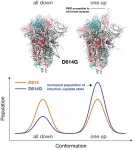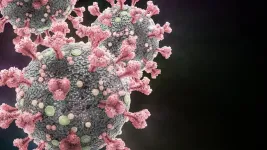Simulations reveal how dominant SARS-CoV-2 strain binds to host, succumbs to antibodies
Dominant G-form Spike protein 'puts its head up' more frequently to latch on to receptors, but that makes it more vulnerable to neutralization
2021-04-16
(Press-News.org) LOS ALAMOS, N.M., April 16, 2021 -- Large-scale supercomputer simulations at the atomic level show that the dominant G form variant of the COVID-19-causing virus is more infectious partly because of its greater ability to readily bind to its target host receptor in the body, compared to other variants. These research results from a Los Alamos National Laboratory-led team illuminate the mechanism of both infection by the G form and antibody resistance against it, which could help in future vaccine development.
"We found that the interactions among the basic building blocks of the Spike protein become more symmetrical in the G form, and that gives it more opportunities to bind to the receptors in the host -- in us," said Gnana Gnanakaran, corresponding author of the paper published today in Science Advances. "But at the same time, that means antibodies can more easily neutralize it. In essence, the variant puts its head up to bind to the receptor, which gives antibodies the chance to attack it."
Researchers knew that the variant, also known as D614G, was more infectious and could be neutralized by antibodies, but they didn't know how. Simulating more than a million individual atoms and requiring about 24 million CPU hours of supercomputer time, the new work provides molecular-level detail about the behavior of this variant's Spike.
Current vaccines for SARS-CoV-2, the virus that causes COVID-19, are based on the original D614 form of the virus. This new understanding of the G variant -- the most extensive supercomputer simulations of the G form at the atomic level -- could mean it offers a backbone for future vaccines.
The team discovered the D614G variant in early 2020, as the COVID-19 pandemic caused by the SARS-CoV-2 virus was ramping up. These findings were published in Cell. Scientists had observed a mutation in the Spike protein. (In all variants, it is the Spike protein that gives the virus its characteristic corona.) This D614G mutation, named for the amino acid at position 614 on the SARS-CoV-2 genome that underwent a substitution from aspartic acid, prevailed globally within a matter of weeks.
The Spike proteins bind to a specific receptor found in many of our cells through the Spike's receptor binding domain, ultimately leading to infection. That binding requires the receptor binding domain to transition structurally from a closed conformation, which cannot bind, to an open conformation, which can.
The simulations in this new research demonstrate that interactions among the building blocks of the Spike are more symmetrical in the new G-form variant than those in the original D-form strain. That symmetry leads to more viral Spikes in the open conformation, so it can more readily infect a person.
A team of postdoctoral fellows from Los Alamos -- Rachael A. Mansbach (now assistant professor of Physics at Concordia University), Srirupa Chakraborty, and Kien Nguyen -- led the study by running multiple microsecond-scale simulations of the two variants in both conformations of the receptor binding domain to illuminate how the Spike protein interacts with both the host receptor and with the neutralizing antibodies that can help protect the host from infection. The members of the research team also included Bette Korber of Los Alamos National Laboratory, and David C. Montefiori, of Duke Human Vaccine Institute.
INFORMATION:
The team thanks Paul Weber, head of Institutional Computing at Los Alamos, for providing access to the supercomputers at the Laboratory for this research.
The Paper: "The SARS-CoV-2 Spike variant D614G favors an open conformational state," Science Advances. Rachael A. Mansbach, Srirupa Chakraborty, Kien Nguyen, David C. Montefiori, Bette Korber, S. Gnanakaran. DOI: 10.1126/sciadv.abf3671
The Funding: The project was supported by Los Alamos Laboratory Directed Research and Development project 20200706ER, Director's Postdoctoral fellowship, and the Center of Nonlinear Studies Postdoctoral Program at Los Alamos.
About Los Alamos National Laboratory
Los Alamos National Laboratory, a multidisciplinary research institution engaged in strategic science on behalf of national security, is managed by Triad, a public service oriented, national security science organization equally owned by its three founding members: Battelle Memorial Institute (Battelle), the Texas A&M University System (TAMUS), and the Regents of the University of California (UC) for the Department of Energy's National Nuclear Security Administration.
Los Alamos enhances national security by ensuring the safety and reliability of the U.S. nuclear stockpile, developing technologies to reduce threats from weapons of mass destruction, and solving problems related to energy, environment, infrastructure, health, and global security concerns.
LA-UR-21-23641
[Attachments] See images for this press release:

ELSE PRESS RELEASES FROM THIS DATE:
2021-04-16
Researchers within the Biomedicine Discovery Institute at Monash University have made a breakthrough in understanding the role played by high-risk immune genes associated with the development of rheumatoid arthritis (RA).
The findings, published in Science Immunology, were the result of a seven-year collaboration led by Monash University, involving Janssen Research and Development, USA and the Karolinska Institute, Sweden.
Certain immune system genes, called Human Leukocyte antigen (HLA)-DR4, cause an increased susceptibility to RA. In this study, using mice genetically ...
2021-04-16
The social science literature has long viewed homophily and network-based job recruitment as crucial drivers of segregation. Researchers at Linköping University and ESADE, Ramon Llull University now show that this view must be revised. In their Science Advances article, they call attention to a previously unidentified factor, the Trojan-horse mechanism, which shows that network-based recruitment can reduce rather than increase segregation levels.
The segregation of labor markets along ethnic and gender lines is an important source of socio-economic inequalities. Therefore, the understanding the mechanisms that drive segregation ...
2021-04-16
Science Advances publishes proteomics technology from Oblique Therapeutics AB with a potential to bring several novel antibody medicines to large patient populations in multiple disease areas
Gothenburg, Sweden, April 16th, 2021 - Oblique Therapeutics AB, a Sweden-based biotech company, in collaboration with Karolinska Institutet (Stockholm, Sweden), Gothenburg University (Sweden) and several local biotechs published promising research results in the highly-acclaimed scientific journal Science Advances (AAAS) entitled: Rational Antibody design for Undruggable Targets using Kinetically Controlled Biomolecular ...
2021-04-16
New Haven, Conn. -- It is well established that autism occurs much more frequently in boys than in girls, and that girls seem to have a greater resilience to developing the condition. It has been unclear, however, why that is.
In a new Yale-led study, researchers find that autism may develop in different regions of the brain in girls than boys and that girls with autism have a larger number of genetic mutations than boys, suggesting that they require a larger "genetic hit" to develop the disorder.
The findings appear in the April 16 edition of the journal ...
2021-04-16
Aging entails a loss of muscle mass and strength, which in some cases impairs mobility, hinders walking or performance of day-to-day tasks, and exposes the elderly to the risk of falls and hospitalizations.
In clinical practice, handgrip measurement is the most widely used method to identify loss of overall muscular strength in older people. Values below 26 kg for men and 16 kg for women have for some time been considered an indication of risk-associated weakness, but these parameters are being revised.
Researchers at the Federal University of São Carlos (UFSCar) in the state of São Paulo, Brazil, collaborating with colleagues at other institutions in the same state such as the University of São Paulo's Ribeirão Preto Medical School (FMRP-USP), Nursing School ...
2021-04-16
Although antibodies induced by SARS-CoV-2 infection are largely protective, they do not completely protect against reinfection in young people, as evidenced through a longitudinal, prospective study of more than 3,000 young, healthy members of the US Marines Corps conducted by researchers at the Icahn School of Medicine at Mount Sinai and the Naval Medical Research Center, published April 15 in The Lancet Respiratory Medicine.
"Our findings indicate that reinfection by SARS-CoV-2 in health young adults is common" says Stuart Sealfon, MD, the Sara B. and Seth M. Glickenhaus Professor of Neurology at the Icahn School of Medicine at Mount Sinai and senior author of the paper. "Despite a prior COVID-19 infection, young people can catch the virus ...
2021-04-16
In recent years there has been an exhaustive study of red dwarf stars to find exoplanets in orbit around them. These stars have effective surface temperatures between 2400 and 3700 K (over 2000 degrees cooler than the Sun), and masses between 0.08 and 0.45 solar masses. In this context, a team of researchers led by Borja Toledo Padrón, a Severo Ochoa-La Caixa doctoral student at the Instituto de Astrofísica de Canarias (IAC), specializing in the search for planets around this type of stars, has discovered a super-Earth orbiting the star GJ 740, a red dwarf star situated some 36 light years from the Earth.
The planet orbits its star with a period of 2.4 days and its mass is around 3 ...
2021-04-16
One of the most comprehensive statistical analyses of drivers of food insecurity across 65 countries has concluded that household income consistently explains more discrepancy in food security than any other factor, including agricultural land resources and production. The Thayer School of Engineering at Dartmouth study, "Cross-national analysis of food security drivers: comparing results based on the Food Insecurity Experience Scale and Global Food Security Index," was recently published by the peer-reviewed journal Food Security.
Given the persistent issue of food insecurity--one of the United Nation's sustainable development goals is to achieve zero hunger--the study's results are vital in determining how best to tackle the complex problem.
"We're ...
2021-04-16
Boulder, Colo., USA: Volcanologists' ability to estimate eruption risks is largely reliant on knowing where pools of magma are stored, deep in the Earth's crust. But what happens if the magma can't be spotted?
Shane Rooyakkers, a postdoctoral scholar at GNS Science in New Zealand, grew up in the shadow of Mount Taranaki on the country's North Island, hiking on the island's many volcanoes. Today, his research is revealing hidden dangers that may have been beneath his feet all along.
A new study, published yesterday in Geology, explores a threat volcanologists discovered only recently: surprisingly shallow magma pools that are too small to be detected with common volcano monitoring equipment. Such a magma body was ...
2021-04-16
LA JOLLA, CALIF. - April 16, 2021 - Scientists at Sanford Burnham Prebys have identified a set of human genes that fight SARS-CoV-2 infection, the virus that causes COVID-19. Knowing which genes help control viral infection can greatly assist researchers' understanding of factors that affect disease severity and also suggest possible therapeutic options. The genes in question are related to interferons, the body's frontline virus fighters.
The study was published in the journal Molecular Cell.
"We wanted to gain a better understanding of the cellular response to SARS-CoV-2, including what drives a strong or weak response to infection," says Sumit K. Chanda, Ph.D., professor and director of the Immunity and Pathogenesis Program at Sanford Burnham Prebys and lead ...
LAST 30 PRESS RELEASES:
[Press-News.org] Simulations reveal how dominant SARS-CoV-2 strain binds to host, succumbs to antibodies
Dominant G-form Spike protein 'puts its head up' more frequently to latch on to receptors, but that makes it more vulnerable to neutralization






